The dental services market refers to the industry that provides dental care services to patients, including preventive and corrective procedures for teeth and gums. This market includes services such as routine cleanings, fillings, extractions, root canals, crowns, bridges, braces, implants, and other procedures.
Dental services can be provided by various types of dental providers, including general dentists, orthodontists, endodontists, periodontists, oral surgeons, and prosthodontists. These services can be offered in private dental practices, community health clinics, hospitals, and other healthcare facilities.
The dental services market is growing due to several factors, including an aging population, increased awareness of the importance of oral health, and advances in dental technology. Additionally, the demand for cosmetic dental services, such as teeth whitening and veneers, has also contributed to the growth of the market.
The global dental services market size will reach around USD 699.7 billion by 2032 and expanding at a CAGR of 4.93% from 2023 to 2032.
A significant rise in the prevalence of oral diseases is fostering the growth of the global dental services industry, globally. According to the World Health Organization (WHO), “Oral diseases are among the most common non-communicable diseases worldwide, affecting an estimated 3.5 billion people. The burden is increasing, particularly in low- and middle-income countries.”
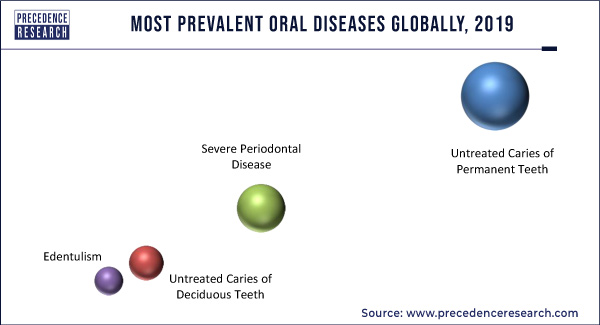
In 2019, the most prevalent oral diseases were untreated caries of permanent teeth that affected around 2 billion people, severe periodontal disease followed with around 1 billion cases, then untreated caries of deciduous teeth with about 510 million cases, and edentulism with 350 million cases, globally.
According to the World Health Organization, oral diseases are a major public health problem that affects individuals, communities, and healthcare systems worldwide. The cost of treating oral diseases can be substantial, both for individuals and for healthcare systems.
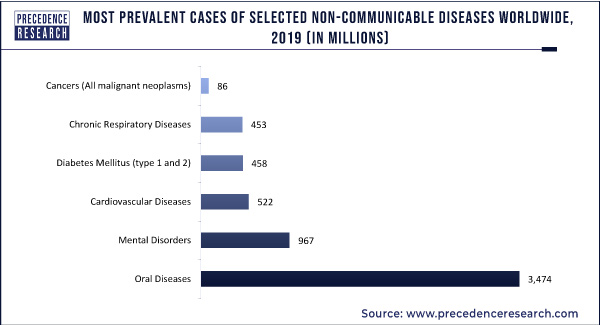
The rising number of oral diseases has a significant impact on the dental services market. Oral diseases, such as tooth decay, gum disease and oral cancer, are common and can have serious consequences if left untreated. As the incidence of oral diseases increases, the demand for dental services also increases. This creates opportunities for dental providers to offer a wide range of preventive and corrective procedures to treat these conditions. This includes routine check-ups and cleanings, as well as more advanced procedures like fillings, root canals, and extractions.
Therefore, the rising number of oral diseases underscores the importance of preventive dental care, early detection, and timely treatment. This creates an opportunity for dental service providers to promote good oral health practices and provide high-quality dental services to meet the growing demand for dental care.
Furthermore, a significantly growing geriatric population across the globe is expected to boost the demand for dental services in the foreseeable future. According to the World Health Organization (WHO), “By 2030, 1 in 6 people in the world will be aged 60 years or over. At this time the share of the population aged 60 years and over will increase from 1 billion in 2020 to 1.4 billion. By 2050, the world’s population of people aged 60 years and older will double (2.1 billion). The number of persons aged 80 years or older is expected to triple between 2020 and 2050 to reach 426 million.”
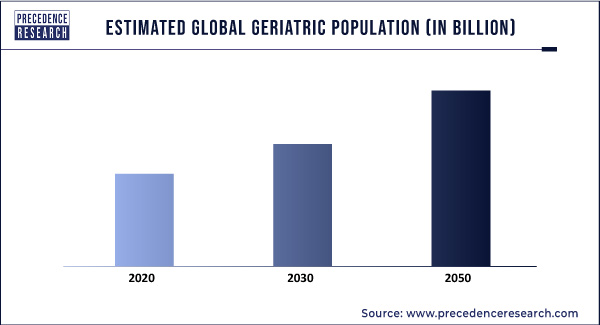
The growing geriatric population is expected to boost the growth of the dental services industry in the forthcoming years. As people age, they are more prone to oral health problems, such as tooth loss, gum disease, and oral cancer. This is expected to foster the demand for the various types of dental services such as dental implants, preventive dental care, dentures, cosmetic dentistry, root canal therapy, and gum disease treatment. This creates opportunities for dental service providers to offer a wider range of services and treatments to meet the needs and demand of this population.
Furthermore, advances in dental technology have made it easier to provide dental care to older adults. For example, digital imaging and 3D printing have improved the accuracy and precision of dental prosthetics, making them more comfortable and functional for older patients.
Moreover, the increasing number of older adults who have retained their natural teeth are also expected to have a positive impact on the market. As people age, they are more likely to keep their natural teeth than in previous generations. This has created a demand for preventive dental care and cosmetic dental services to maintain and improve the appearance and functionality of their teeth.
Dentists play a crucial role in the growth of the dental services industry. They are at the forefront of providing dental care services to patients and are responsible for diagnosing, treating, and preventing oral health problems. Dentists are trained to provide a wide range of dental services, from routine cleanings and fillings to more complex procedures such as root canals and dental implants. They use their knowledge and expertise to provide high-quality care to their patients. Furthermore, dentists play an important role in promoting preventive care, such as regular dental check-ups, cleanings, and fluoride treatments. By educating their patients about the importance of good oral hygiene, dentists can help prevent many oral health problems before they develop.
The growing adoption of advanced technologies by the dentists is further expected to boost the market growth in the near future. Many dentists invest in advanced dental technology to provide more accurate and efficient treatments to their patients. This includes digital imaging, laser dentistry, and 3D printing, which can improve the accuracy and precision of dental procedures. Moreover, dentists also contribute to research and development in the dental field, which can lead to new and improved dental treatments and technologies.
Estimated Number of Dentists, By Country, 2020
| Country | 2020 |
| Argentina | 35,569 |
| Australia | 16,153 |
| Austria | 5,206 |
| Belgium | 8,871 |
| Brazil | 1,43,178 |
| Canada | 24,909 |
| Chile | 26,685 |
| China | 6,38,000 |
| Colombia | 53,560 |
| France | 42,844 |
| Germany | 71,108 |
| India | 2,22,816 |
| Indonesia | 32,418 |
| Italy | 51,678 |
| Italy | 1,04,152 |
| Italy | 14,528 |
| Netherlands | 9,879 |
| New Zealand | 2,644 |
| Portugal | 11,670 |
| South Korea | 26,978 |
| Russia | 50,642 |
| Saudi Arabia | 19,622 |
| South Africa | 6,586 |
| Spain | 39,764 |
| United Arab Emirates | 6,860 |
| UK | 36,394 |
| U.S. | 2,02,241 |
The dental services industry in the U.S. is a large and growing sector that provides a wide range of services related to oral health and hygiene. The dental services industry in U.S. is highly fragmented, with many small and independent practices, as well as large dental service organizations (DSOs) and dental chains. Some of the major players in the industry include Aspen Dental, Heartland Dental, Pacific Dental Services, and Smile Brands.
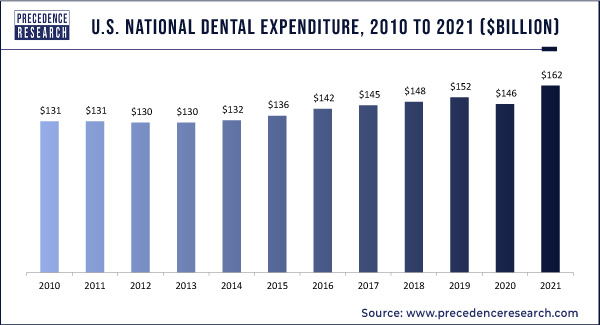
There are several factors that are fueling the growth of the dental services industry in the US. One of the main drivers is the aging population, which is increasing demand for dental services among older adults. Additionally, rising disposable incomes and an increasing awareness of the importance of oral health are also driving demand for dental services.
Furthermore, the increasing adoption of digital technology, such as digital imaging, 3D printing, and laser dentistry, which is improving the accuracy and efficiency of dental procedures are significantly fostering the growth of the dental services market. Additionally, the industry is witnessing a growing focus on preventive care, with many dental practices offering educational programs and resources to help patients maintain good oral health. Moreover, the favorable government policies pertaining to reimbursement from healthcare insurance providers are expected to positively impact the market growth in the U.S.
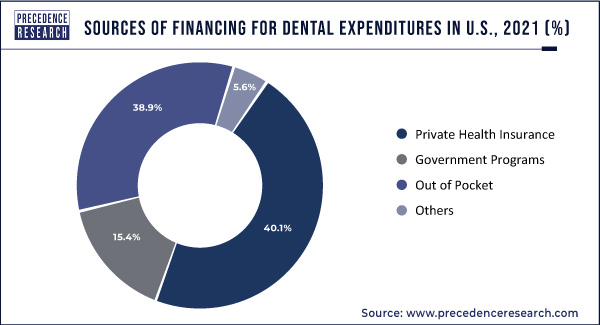
Despite its growth and potential, the dental services industry in the U.S. faces several challenges, including rising costs and competition from other healthcare providers. Additionally, the industry is subject to regulations and licensing requirements, which can vary by state and can be complex and time-consuming to navigate.
Asia Pacific region is expected to grow at the highest CAGR in the near future, owing to the various factors such as rising aging population, presence of huge population, growth in the investments in developing healthcare infrastructure, growth in the penetration of dental and healthcare units, and rise in the awareness regarding the various dental services. According to the United Nations, around 80% of the global geriatric population will be living in the low and middle-income nations by 2050.
Furthermore, Asia Pacific is the home to around 60% of the global population, which offers more opportunities to the dental service providers to grow. Moreover, as per the data published by the WHO, around 93% of global fatalities on roads occur in the low and middle-income nations. Approximately 1.3 million people die each year as a result of road traffic crashes. The rise in the number of road accidents may boost the demand for the various dental services in the forthcoming years.
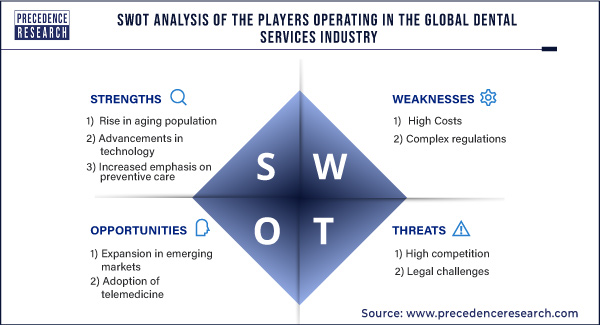
Strengths:
Weaknesses:
Opportunities:
Threats:
Telehealth has been increasingly gaining popularity in the healthcare industry over the past few years. It involves the use of technology to provide remote healthcare services to patients. One of the areas where telehealth has had a significant impact is in the dental services industry. The role of telehealth in the growth of the dental services industry can be examined from various angles.
Firstly, telehealth has improved access to dental services for patients in remote or underserved areas. In many parts of the world, there is a shortage of dental practitioners, and patients have to travel long distances to access dental services. According to WHO, “Over 68% of WHO Member States report to have less than 5 dentists per 10 000 population (about 37% report to have less than 1).” Telehealth has made it possible for patients in such areas to receive dental consultations and treatment remotely. Dental practitioners can use video conferencing, messaging, or other communication tools to diagnose and treat patients without physical contact. This has improved access to dental services for patients who would otherwise have to go without.
Secondly, telehealth has made dental services more affordable. By eliminating the need for patients to travel long distances to see a dentist, telehealth has reduced the cost of dental care. Patients no longer have to pay for transportation, accommodation, and other expenses associated with travel. Additionally, telehealth services are often cheaper than in-person consultations, making dental care more affordable for low-income patients. Further, the government regulations pertaining to the reimbursements associated with telehealth services may further boost the demand for the dental services among the consumers.
Furthermore, telehealth has improved the efficiency of dental services. With telehealth, dental practitioners can see more patients in less time. They can attend to patients without leaving their office, which saves time and reduces the need for expensive dental equipment. This, in turn, has increased the productivity of dental practitioners and improved the overall efficiency of the dental services industry.
Finally, telehealth has improved the quality of dental services. By providing remote consultations, dental practitioners can collaborate with other healthcare professionals and access specialist advice. This has improved the accuracy of diagnosis and treatment, resulting in better outcomes for patients. Additionally, telehealth has made it easier for dental practitioners to monitor the progress of their patients and provide follow-up care. This has reduced the risk of complications and improved patient satisfaction.
Therefore, telehealth has played a significant role in the growth of the dental services industry. It has improved access to dental services, made dental care more affordable, improved the efficiency of dental services, and enhanced the quality of dental care. As technology continues to advance, it is likely that telehealth will become an increasingly important part of the dental services industry.
The North American dental services industry has been growing steadily over the years and is projected to continue its growth trajectory in the coming years. The increasing demand for dental services due to the rising prevalence of dental diseases, the growing geriatric population, and the increasing awareness about oral hygiene are some of the factors driving the growth of this industry.
Investing in the North American dental services industry can be a lucrative opportunity for investors due to its potential for growth and profitability. The industry is expected to witness significant growth in the coming years due to the increasing demand for dental services, technological advancements, and the rising trend of dental tourism.
One of the ways to invest in the dental services industry is by investing in dental service providers. There are several dental service providers in North America, including dental clinics, dental laboratories, and dental product manufacturers. These providers offer a range of services, including preventive care, restorative care, orthodontics, cosmetic dentistry, and oral surgery.
Furthermore, by investing in dental products and equipment manufacturers. These companies produce dental equipment such as dental chairs, imaging equipment, and other tools required for dental procedures. The dental products industry is also growing, with new products being introduced regularly to cater to the growing demand for dental care.
The Asia Pacific dental services industry is a rapidly growing sector that is expected to see strong growth in the coming years. The region is home to a large and growing population, which is driving demand for dental services. In addition, rising incomes and improved access to healthcare are also fueling growth in the industry. Asia Pacific is expected to be the fastest-growing market in the near future, which makes it an attractive market for investment.
Dental implants and cosmetic dentistry have played a significant role in the growth of the dental services industry. Over the years, dental treatments have evolved significantly, and dentists are now able to offer a wide range of services to their patients, thanks to advancements in technology and techniques.
Dental implants, in particular, have become a popular tooth replacement option in recent years. They are a type of artificial tooth root that is surgically placed into the jawbone. Once the implant has fused with the jawbone, a dental crown or bridge is attached to it, creating a natural-looking tooth replacement. Dental implants are more durable and long-lasting than other tooth replacement options such as dentures or bridges, which tend to wear out over time. As a result, dental implants have become a significant revenue stream for dentists, contributing to the growth of the dental services industry.
Cosmetic dentistry, on the other hand, focuses on improving the appearance of teeth, gums, and the overall smile. It includes treatments such as teeth whitening, veneers, and dental bonding. With the increasing demand for cosmetic dentistry, dentists are now able to offer a wider range of services to their patients, helping them achieve their desired smile. This has led to an increase in revenue for dental practices that offer cosmetic dentistry services.
Furthermore, the growth of the dental services industry has been driven by increased awareness among the public about the importance of dental health. People are now more willing to invest in their oral health, and dental practices have responded by offering a wide range of services to meet their needs. In addition, advancements in technology have made dental treatments more accessible, affordable, and less invasive than ever before.
The market is moderately fragmented due to the presence of numerous local companies. These market participants are pursuing methods like investments, collaborations, acquisitions, and mergers in an effort to increase their market share. Also, businesses are investing in the creation of better services. They are also concentrating on keeping their prices competitive.
In the coming years, the market for dental services will grow as a result of recent developments and advancements such as the introduction of invisible braces and tray systems, laser dentistry techniques, cutting-edge digital X-Ray technology, innovative tooth repair materials, and instant teeth whitening procedures.
The major players in the market include Pacific Dental Services, Dental Services Group, Q & M Dental Group, Apollo White Dental, Coast Dental, Axiss Dental, Gentle Dental of New England, Abano Healthcare Group, Smile 360, and Healthway Medical Corporation.
View Full Report@ https://www.precedenceresearch.com/dental-services-market
You can place an order or ask any questions, please feel free to contact at sales@precedenceresearch.com | +1 650 460 3308

Aditi, Vice President at Precedence Research, brings over 15 years of expertise at the intersection of technology, innovation, and strategic market intelligence. A visionary leader, she excels in transforming complex data into actionable insights that empower businesses to thrive in dynamic markets. Her leadership combines analytical precision with forward-thinking strategy, driving measurable growth, competitive advantage, and lasting impact across industries.

Aman Singh with over 13 years of progressive expertise at the intersection of technology, innovation, and strategic market intelligence, Aman Singh stands as a leading authority in global research and consulting. Renowned for his ability to decode complex technological transformations, he provides forward-looking insights that drive strategic decision-making. At Precedence Research, Aman leads a global team of analysts, fostering a culture of research excellence, analytical precision, and visionary thinking.

Piyush Pawar brings over a decade of experience as Senior Manager, Sales & Business Growth, acting as the essential liaison between clients and our research authors. He translates sophisticated insights into practical strategies, ensuring client objectives are met with precision. Piyush’s expertise in market dynamics, relationship management, and strategic execution enables organizations to leverage intelligence effectively, achieving operational excellence, innovation, and sustained growth.

Viral vector gene therapies are gaining traction, with the rise in genetic and rare disorders, recent FDA approvals, and...
14 Nov 2025
Among Gen Z and millennials, wellness is an everyday ritual, not just an occasional activity. The expansion of wellness...
13 Nov 2025
Generative AI: Why a Game Changer for Healthcare? Recently, generative AI is gained significant traction in the healthc...
06 Nov 2025